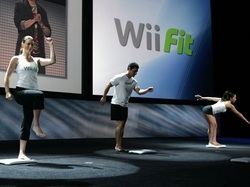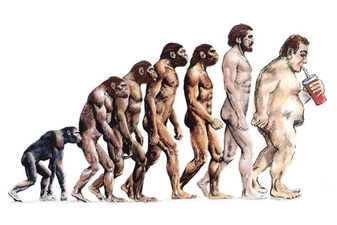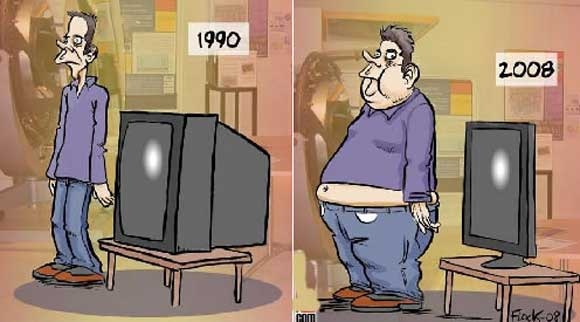 According to AppBrain there are currently over 600,000 different apps that are available for download to a smart phone. Of those apps 1,500(number form the Pew Research Center 2011) are fitness apps that are available on ITunes. Even though the number of fitness apps compared to the overall amount seems quite small, this number is still a staggering amount. Breaking it down, it means that there are 1,500 different individuals that feel that their app is the best way to get fit and don’t forget that is 1,500 different opinions each app is providing as well. This can become overwhelming for a consumer to search and find an option that works for them. Once they find one that they believe fits them best, will the app actually work? According to a study conducted by BYU, 127 most the most popular fitness apps were rated on a points scale from 1 to 100. From this study they found that the overwhelming majority of the apps were lacking scientific theories for behavioral change. This ultimately misleads the consumer trying to become more fit. Without having a strong scientific base the application is extremely generalized, thus not being able to reach the extreme populations. An example of who falls in this extreme population would be the obese. For many of these individuals their resting metabolic rate plays a vital role in losing weight. If a dietician, doctor, exercise physiologist, and in this case an app, does not know the resting metabolic measurement the approach for this patient is all guessing, thus leaving hope in solely that cutting an amount of caloric intake will be enough. This is essentially what is happening with the generic health apps that are overflowing on the virtual market. In no way am I saying that health apps are bad for an individual. They are still able to be used as a motivator for individuals. The point is that to what extent will the apps actually aid and motivate other users? Will these apps actually be able to aid in becoming more fit even to the extent of curing obesity? These are all relevant questions to be asked. The main focus is to just get society moving for some time throughout the day. If these apps do that in even the slightest fashion I see it as a true success story. Noah E.
As we can see in our modern day society, technology has undoubtedly played a substantial role, if not the overarching causal factor, of increased levels of obesity. In fact, I would venture to say that we are so far down the hole that we cannot be certain as to if and when we may eventually climb out of this hole. However, if there is one vehicle that is capable of providing us with transportation to the 'promise land' of healthy body fat percentages and body mass indexes, it is the exact thing that brought us there in the first place: technology. There was a study conducted in which 20 students signed up to receive texts from their teacher in an attempt to provide consistent encouragement to eat healthier and exercise more. However, the ability to really gauge the results of this experiment was extremely difficult and therefore the results were unable to be firmly established. Following this failed experiment, another test was performed in which a much larger population was utilized and with a different variable this time: the Zamzee. This gizmo is intended to provide an enjoyable atmosphere for kids so that they desire to participate in activities that will result in an increase in fitness and decrease in obesity levels. For example, there are incentives and rewards for kids if they reach certain levels on their Zamzee and therefore experience a motivation that drives them to perform. Researchers discovered that those individuals participating in the study who were obese experienced a 59% increase in minutes of activity each week after utilizing the Zamzee. The most interesting piece about this study was that researchers were intentional about not mentioning exercise or fitness around the kids who were obese because they know words similar to those trigger a psychological shut down in the sense that they don't want to hear about them anymore. Reading about these experiments is an effective way to witness the fact that technology can provide an excellent venue for reversing the effect in which it initially helped cause. One thought that really caught my attention was the idea that we have the answers in front of us, we simply need to manipulate and incorporate them in the proper manners in order to yield the results that we desire to see. For example, children will respond significantly better as seen in the experiment above when they are driven by a motivation other than someone telling them they need to exercise to be in better shape. Kids enjoy receiving applause and rewards for their behavior and that is something that a piece of technology such as the Zamzee can provide if we allow it to and stop trying to beat it into people. Thought technology may have initially been what sent us down this slippery slope, it can most definitely be our shining star if we begin attempting new and innovative methods to appeal to the obese children in a unique way. Josh T.
"Obesity currently is the second leading cause of preventable death and will soon surpass cigarette smoking, the leading cause." Back in the late 1960's, only 8.8% of the population that ranged from 2-19 years old were obese. A survey taken in 2003-2004 states that now 50.1% of the population is now obese. That is a 41.3% increase over the span of approximately 35 years. You would think that in today's society with all the access we have to gyms, weight loss diets, video game exercising, sports, and many other things, that we would be able to keep this vital part of our lives under control. In my childhood, 12-15 years ago, the only thing that I would ever think of doing was going outside to play sports. My parents encouraged me to go outside all the time and to stay active. Now, it seems as if a lot of parents would rather their kids stay inside and watch TV or play video games because then they don't have to watch them, they can sit inside and do whatever they want to do. As funny as this evolutionary picture may look, it's not funny at all. It's actually quite sad. Especially when approximately 300,000 lives are taken each year because of obesity. Not only is obesity taking lives, but it's also a big contributor to our debt. The economic cost of obesity per year is roughly $117 billion. It seems like we're never happy with how the governments money is being spent, when really we're in control of a major debt contributor. Not only could we be saving lives, but we could also be saving money if we cut some technology out of our lives, and made it a point to exercise daily. Unfortunately, based on our societies actions, surveys have estimated that by 2030, roughly 18 million more Americans will become obese. When is it going to be too much? It is safe to say that obesity is not only evolving, it is taking over. Kristi K.
There is no debate concerning the current all-time levels of obesity within our country, however, the relationship of obesity with technology has two sides to the coin. On one side of the spectrum you have those who identify technology as the sole perpetrator for the heightened levels of obesity over the past decade and claim that if we had not developed such a sweet tooth for screens, we would not have the conundrum on our hands that we do now. A recent article in the New York Times, the average kid between the ages of 8 and 18 spends over seven and a half hours a day utilizing a myriad of technological gizmos. Furthermore, the Kaiser Family Foundation discusses that these same kids are only obtaining thirty-eight minutes of old fashioned readings. These poor habits are extremely detrimental to the individuals’ outlook on life in the sense that they begin establishing a lazy mindset that will eventually lead to more obvious effect that we see in the obesity levels. According to the Center for Disease Control and Prevention, the percent of children that are between the ages of 6 and 19 has tripled over the course of the past twenty years and that this is primarily due to electronic usage. Contrary to popular belief, kids are unable to effectively burn off necessary calories while sitting on their butts in front of the TV. On the other side of the coin, there are those who firmly believe that technology is the singular thing that possesses the potential to turn this nation’s habits around and serve as the catalyst to minimize these levels of obesity. For example, some pieces of technology such as the 'Fitbit' have provided incredible opportunities for individuals who struggle to consistently exercise and serve as a gadget that people are intrigued by and desire to actually implement into their lives. Additionally, there are countless applications that can be downloaded onto various smartphones that are extremely helpful in keeping track of caloric intake, caloric expenditure, number of steps taken in a day, necessary exercise, etc. An interesting quote from a journal states the following, "While it was the technology of the 20th century that instigated the obesity epidemic, it will most certainly be the technology of the 21st century that solves it." There is quite the captivating dichotomy between these two schools of thought and it will be even more interesting to see which side claims victory over the course of the next twenty or thirty years. Josh T.
 “The noble purpose of which is to get gamers to shed those unwanted pounds.” This is a direct quote from Nintendo Wii and what their intentions are for making Wii Fit. They like to refer to it as less of a video-game and more of a “fitness coach,” even though in the end it’s still a video-game. The main areas that Wii Fit focuses on are strength training, aerobics, yoga and balance. They have games that fit into each category as you can see shown on the Wii Fit box. As I looked up articles to see statistics on the results of Wii Fit for people who continuously use it, I found a specific article about a man who experimented using Wii Fit for 41 days straight and lost 15 pounds. He said he easily "played" (exercised) 30 to 60 minutes every single day. Although after his experiment, he like many other people in the world got consumed in his life and didn't have "time" to exercise. We all are too busy with school, or work, our family/friends, and other activities that we let ourselves lose track of the importance in being healthy. Are we fit? No. According to WedMD, in 2009, a study showed that 63.1% of adults are either overweight or obese. Technology is one of the top three contributors to obesity in children, which makes it much more prevalent to be obese as an adult. With video games being something a lot of people enjoy, thinking of a way to implement exercise into them was a great idea. However now as a generation, we need to take that initiative to use the resources we have. If we don’t have time to fit in 30 minutes of exercise, then we’re too busy. Kristi K.
“Bigger and Better” that is the true American way. This is especially true in our culture when it comes to size of our televisions. Oddly enough this same concept is following a trend in the size of our people. Obviously as a majority we are as a society a sedentary country and the television is a prime encourager of being encourager. According to the CDC the television is on seven hours a day. They have also found that individuals who watch it for three or more hours a day are twice as likely to be obese compared to those who allow themselves only one hour a day. So how does all of that time correlate with an increase in obesity? The first reason is clearly the amount of time that is spent being sedentary, however, an observation is needed on other activities that occur during this sedative time. For example a common practice that is associated with a movie is eating popcorn. This also holds true for snacking while watching television. Time of being sedentary while adding in extra calories is a clear equation to add on the extra weight. It becomes a subconscious habit for many. The main issue is not the overeating, but the fact that the technological medium entices us to a point that we do not realize that choices that we are making have major health implications. When as a society will we start taking ownership for the choices we make with the television? It is ironic that we watch hour long reality shows on television that show obese individuals losing weight (ex: The Biggest Loser) that is encouraging and motivating us, but yet we are still on the couch not taking any action. It is almost as if the television is mocking us sending the message to go exercise when it knows that we will still be sitting there watching the show. In no way am I saying this relates to every individual who watches television or that watching the Biggest Loser cannot encourage others to become more fit. My point is that we need to become more aware of the message the medium is sending and how those implications are affecting the health of society. Noah E.
 Kids who play video games are twice as likely to become obese than kids who don’t. Personally, as someone who is always surrounded by exercise I find that to be an important aspect of everyday life. When I was younger, technology wasn’t as prevalent as it is now. My siblings, friends and I would go outside every single day and play baseball, street hockey, and basketball. Nowadays, I nanny kids who are 8 years old, often times they would rather sit inside and play Xbox or on their iPods rather than go outside and play.
I feel as if video games are the biggest threat to young kids in terms of contributing to obesity, especially for boys. Throughout my past few years at college I can’t help but notice that a lot of young men get involved in video games. Instead of doing homework or going to the gym a lot of them get consumed in Call of Duty, or NHL 2013. I feel as if technology as a whole has contributed to the increase in obesity however more specifically the effect video games has had is a major main contributor.
Some people may wonder why is obesity more prevalent in America? Not only do we have the resources, however, we also have the 'social status' to afford all of today's newest technology. It's so important to establish healthy habits and a lot of exercise starting in the childhood years, because as people get older it only gets harder. When you're young your metabolism is fast and always burning calories, but when you get older it slows down and is much harder to lose weight.
Why have things changed so much in the course of ten years? Why don't kids want to spend all day outside in the sun playing sports? What have we done as a society and generation to contribute to stopping this? I think we need to assess this and genuinely think about it before things get too out of hand - if it isn't too late already.
Kristi K.
Video games, Television, the Internet are all the bad guys for encouraging children and teenagers to be lazy and become physically sedative. The average time a day that children age 8-18 spend on entertaining media a day is an average of seven and a half hours according to a national survey conducted by the Kaiser Family Foundation. That equates to seven and a half hours a day that they are sedative and not active. It is obvious that it is a major contributor in adding to the obesity epidemic of our children in this country. Since a major cause of childhood obesity has been identified (technology devices) how can it be reversed and prevented? School education programs on health fitness have obviously been ineffective due to the fact that there is still an overwhelmingly large population of large little ones. Recent research in the Journal of the American Medical Association claims that one third of all the children in America are either overweight or obese. This number shows that something needs to be done to change the approach of how fitness and health is being presented to this population. The answer is to fight fire with fire, or in this case technology with technology. The fight against obesity with the use of technology is starting to take off in targeting the younger population. It has been seen how the use of different mediums of technological use in adults have shown success in becoming more active and making healthier lifestyle choices, but none of these methods have been successful for children until recently. Adults have been using gadgets that have allowed them to track the progress they are making when being physically active throughout the day and it has been shown to be a successful motivator (seeing the data from the physical activity they performed throughout the day), but for children it has not been as of an intriguing medium. This idea has recently started to change. There is a new product on the market called a Zamzee. This product embraces the idea of using medium of the internet and a virtual game that kids already use as a tool to encourage them to become more physically active. It is essentially a pedometer that is connected to the computer that then connects the child to the virtual world of Zamzee. Here the child is able to make an avatar of themselves, see their progress of how active they were during the day, meet other children using the device, and ultimately be rewarded for increasing physically active. Lets be honest what child does not enjoy a reward? This new tool is a huge advancement in using technology as a motivator for children to become more active. Parents are able to access the account and provide the child with a fitness allowance. Once the child reaches the goal they are able to collect the allowance and then purchase items such as small toys, iPods or other gadgets off the website. Now many may ask does will this actually motivate the child? According to a recent study at UCLA the product has had a very positive effect on sedentary children to become just as active as children that are highly active (a 59% increase). This study does support that it will be an effective tool for most children. This new product and recent research findings through UCLA can open a whole new direction on how to attack childhood obesity. It is a sophisticated device and program that uses a positive psychological approach through an inviting medium for the child. Now the Zamzee is not the only product out there to get children more active. For example there are video games where a bike needs to be pedaled to advance through the game as well as other main stream products such as Wii Fit and Xbox Kinect, but yet they are used in a confined medium (the tv) and once the child gets board of them will they just stop playing? Do these products show them results and give them rewards? These are questions to ponder as advances are made in trying to get a younger generation more active. Reviewing a product such as the Zamzee it is my hope that it has only started a momentous push forward on how as a society we can use the inviting medium of technology such as the Internet to make one of the causes of obesity a cure. Noah E.
As I have made the transition from adolescence to adulthood over the course of the past decade, I have also been able to witness first hand the steep regression this country has made concerning the eye-popping level of obesity. The astronomically high levels of overweight individuals in this country is depressing to the point where you really have to stop and wonder if there is any sort hope to amend the situation. Recent studies have discovered that approximately 1 out of every 3 Americans are indeed suffering from this constantly rising epidemic of obesity and that elevating our spending on technology is not helping at all. There is a flawed theory that revolves around the notion of spending more on information and communication technology in order to improve the habits concerning health in this country. However, a recent statistic discovered that for every 10 percent rise in what a country spends on information and communications technology, there is a corresponding 1 percent increase in obesity rates. That is nearly 42 million people in a developed country such as the United States ! How is this possible?
This type of research is extremely disturbing and if we do not begin to intentionally implement specific changes and modify our behavior, then who knows where our health will stand a decade from now. We spend far too much money, time, and effort pouring into other aspects of this country when in reality we need to start investing in people’s health before it spirals out of control. Not only is it unhealthy and life threatening to the individual, but collectively it generates an incredibly lazy atmosphere and culture that we reside in. Technology has the potential to be incredibly beneficial, however, as we continue to invest more money into TV’s and computer screens, the number of people that choose to sit as a result of infatuation with them increases drastically. What can we as individuals start to do in an attempt to reprioritize what is really important in life? There isn’t necessarily one answer to that question, but if we don’t start doing something soon we will undoubtedly pay for it down the road.
Josh T.
|







 RSS Feed
RSS Feed